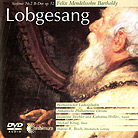March 2002
“Hymns of Praise” uses biblical text in a choral and instrumental arrangement inspired by Beethoven’s Ninth Symphony. The connection with Beethoven was openly admitted, even celebrated, by Mendelssohn. The melding of instrumental and vocal elements is clearly a hallmark of this work. Marcus R. Bosch conducted this arrangement consisting of the Beethoven Chorus of Ludwigshafen and the Dessau Orchestra, with vocalists Jacqueline Treichler, Katharina Wollitz and Michael Konig. The live recording was made in a 1400-seat hall and includes a 48kHz/24-bit five-channel track, which can also be played back using two-channel stereo. Forget using anything but the multichannel track -- and forget thinking that your system is perfectly balanced from front to rear. Turn off the lights, turn up the volume, and slowly bring in the surrounds. When you hear them, back off just a fraction -- there it is! You can achieve a truly live sound with this disc, but it will require more than just a typical effort. What’s good enough for the latest movie soundtrack is not sufficient here. The performance is inspired, and the sonics are excellent. Mendelssohn fans, particularly those who regularly attend live performances, will rejoice in the emotive re-creation of this work. The surround channels are used the way they should be, giving the listener the natural ambience that can only be attained by having rearward-originating sounds coming from the rear. The tonality is spot-on, and the liveness factor is high. The 1:06.56 playing time will pass quickly and leave you waiting for the next performance. I look forward to hearing more from the Nishimura label. They clearly know how to record live, large-scale, symphonic music, and this recording is a fine example of the way it should be done. GO BACK TO: |
 Mendelssohn - Symphony
No. 2 in B-flat Major, op. 52 “Lobgesang”
Mendelssohn - Symphony
No. 2 in B-flat Major, op. 52 “Lobgesang” Mendelssohn’s celebration of the 400-year anniversary of the
printing press was marked with Symphony No. 2 in B-flat Major, op. 52 “Lobgesang,”
or “Hymns of Praise.” Written in 1840, seven years before his death, the work is
Mendelssohn’s representation of spiritual and social enlightenment, which the
printing press represented to him. That event was a human victory over ignorance and
stagnancy, and this work signifies its triumph.
Mendelssohn’s celebration of the 400-year anniversary of the
printing press was marked with Symphony No. 2 in B-flat Major, op. 52 “Lobgesang,”
or “Hymns of Praise.” Written in 1840, seven years before his death, the work is
Mendelssohn’s representation of spiritual and social enlightenment, which the
printing press represented to him. That event was a human victory over ignorance and
stagnancy, and this work signifies its triumph.